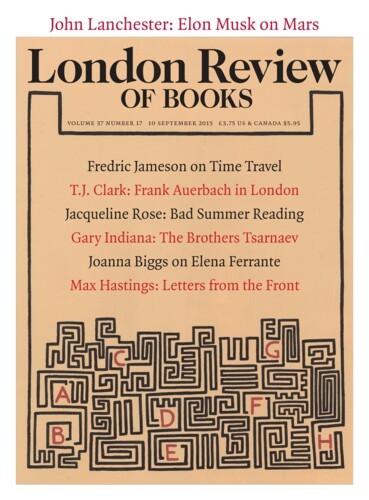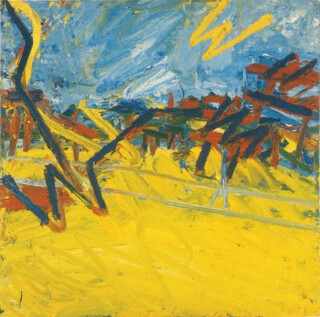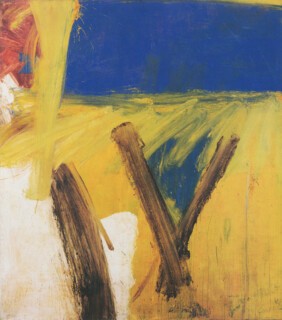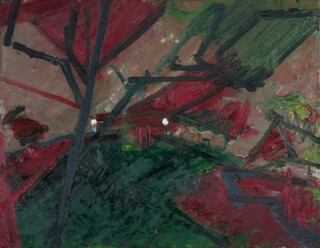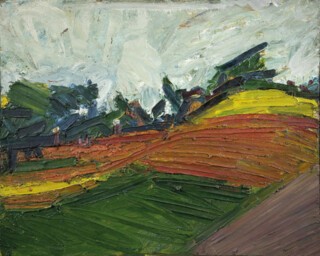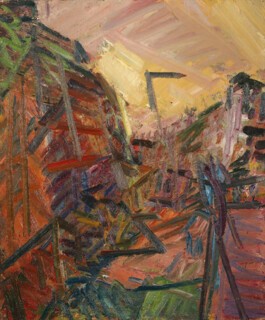That marvellous line from Thomas Hardy’s ‘At the Railway Station’: ‘And the man in the handcuffs suddenly sang/With grimful glee …’
Frank Auerbach to William Feaver
And the man in the handcuffs suddenly sang
With grimful glee:
‘This life so free
Is the thing for me!’
And the constable smiled, and said no word.Thomas Hardy, ‘At the Railway Station, Upway’
I remember the first time I saw, or looked repeatedly at, a painting by Frank Auerbach was in the art historian Michael Podro’s living room – it must have been in 1968. The painting was Primrose Hill, Autumn Morning. I’d barely heard of Auerbach at that point (modern painting for me was French and American), and I certainly didn’t have a clue who had done the painting over Podro’s shoulder. I didn’t ask – partly because there were other things to talk about, and partly because I thought the painting was a crazy inconsequential daub, and assumed Podro thought otherwise, and couldn’t for the life of me imagine why. Weeks went by. I don’t know how many times I sat staring at the Van Gogh zigzag crows over a cornfield – I had no idea that they were English sunbeams over NW1 – but slowly, and not as a result of an act of judgment (or not one I was aware of), the painting took hold of me. I still didn’t dare, or didn’t bother, to ask who had done it. It took hold of me, and I began to see not just that it wasn’t an inconsequential daub, but that it was bloody marvellous – full of grimful glee, full of life and freedom.
This episode has stuck in my mind because it’s as close as I’ve ever come to what is supposed to be the primal scene of modern art: the experience of making (or if you’re a viewer, seeing) something that is truly senseless and preposterous as it comes into being, unknown and unidentifiable, and therefore, if you’re lucky, a glimpse of freedom, a unique particular, a way to slip off the mind-forg’d manacles. The zigzags are the manacles. I hope my elation at the yellow and blue wasn’t just the constable’s smile.
Why the way to freedom in painting should be via the incomprehensible is a question not asked enough of modern art. Many good critics (I think of Clement Greenberg) have grown impatient with the whole idea. But Auerbach’s painting takes it to be axiomatic. And the best of his painting convinces us, or at least me, that the axiom isn’t just assumed to be true in the first place and then the painting produced according to it, but has been discovered – discovered as a way of approaching the world, and then discovered to be a true way – in the painting, as the painting, as what ‘painting’ has become.
All of this, as Auerbach has admitted once or twice to interlocutors, is on the edge of ‘modern art’ mystagogy. But that does not mean we can abandon it:
I think all good painting looks as though the painting has escaped from the thicket of prepared positions and has entered some sort of freedom where it exists on its own, and by its own laws, and inexplicably has got free of all possible explanations. Possibly the explainers will catch up with it again, but never completely.
Elsewhere:
I don’t think one produces a great picture unless one destroys a good one in the process. And one doesn’t make a great picture by destroying a rotten one …
What I’m trying to make is a stonking, independent, coherent image that has never been seen before. To make something that is as blatantly public and as extravagantly new and strange as that, one needs material … And that’s what all the subjects are for. They’re not there for their own sake; they’re not there for sentimental reasons; they’re there to feed this new, independent image that one’s trying to make, that stalks into the world like a new monster.
It would not have altered things much, incidentally, that if I’d been better prepared in Podro’s living room I might have seen that the monstrosity on the wall had been made, partly, out of devouring – destroying – other people’s art. If I’d been able to glimpse a de Kooning landscape from ten years earlier – say, Suburb in Havana from 1958 – lurking under Autumn Morning, I might have been a little less at sea. But the problem would only have shifted ground. I would still have had to sort out why and how de Kooning’s elegant, lavatorial graffiti – his Cuban-blue depth, the lavish decisiveness of his foreground ‘V’ – were turned in the Auerbach into a kind of waterlogged storm-streaked slipperiness. Maybe I’d have twigged it had to do with the climate of London. (Constable smiling.) Just as likely, I’d have continued to be thrown by the blatancy of Auerbach’s kill-the-father.
There are tremendous Primrose Hill pictures in the Auerbach show that opens at Tate Britain on 9 October. Several of them bring on the feeling I had back in 1968. Take the painting called Winter Evening, Primrose Hill Study, done over the winter of 1974-75. What struck me as incomprehensible about it on first sight was the raggedness and spikiness of the lines on its surface, like the spokes of a wind-wrecked umbrella. I could see that the lines, some of them, were meant to stand for trees in winter, but the pattern they made did not seem to emerge from anything organic, and their abstractness did not look to be feeling for an order or consistency (or not one I could grasp), or a fluency, or a principle of growth, and least of all a groundedness or endurance in the things seen. Auerbach is a landscape painter, but of a peculiar kind. Nature for him seems to be instantaneous. It leaps out of the void. The paint contorts to capture it, but always what the impasto seems to be after is not the ‘character’ of a scene, or even its atmosphere, but rather, its simply being there for once. Scale is uncertain. ‘This might be nature – twenty stories high,’ to borrow from Robert Lowell:
We two, one cell here, lie
gazing into the ether’s crystal ball,
sky and a sky, and sky, and sky, till death –
Well – death and the void may be part of it. City parks by night do have something sepulchral about them. The little white blobs of the streetlamps in Winter Evening don’t seem to be holding off January’s chill. But look again at the painting … My language so far has betrayed its fundamental aestheticism. Nature for Auerbach may leap into being, with emptiness and coldness always haunting it, but what matters most about the leap is that it – the thing itself, the scrawled contingency – is beautiful. ‘I do like a clear expression if I can get it – something that seems to lock like a theorem.’ ‘The problem of painting is to see a unity within a multiplicity of pieces of evidence.’ Having lived with Autumn Morning for a while, Podro had this to say about the picture’s blue and yellow zigzags:
The strong paint marks, considered as marks on the surface, were never something with their own interest. They emerged during months of working on the canvas and through sheaves of preparatory drawings done on the spot.
Auerbach said in answer to a question that they do not exist as marks for him, which perhaps indicates that they are not things at which he looks for themselves but for the features and continuities they suggest. They are of interest only in so far as they suggest something else, but they are the starting point of all further suggestion, becoming reinforced [as soon as] details of observation or elaboration threaten to break off into an independent life of their own.
This is fine criticism, but (because the critic and the painter shared so many assumptions) it needs unpacking. What a painting aims for, as Podro sees it – and Auerbach too, judging from the aphorisms just quoted – is unity and particularity at the same time. A picture has to be the record, or the result, of many specific acts of looking and thinking, and it ought to be as concrete as all hell. ‘Painting never wants to be like music,’ Auerbach said once. ‘It is best when it is least like music: fixed, concrete, immediate and resistant to time.’ But that does not mean it should be a collection of particulars, all of them winking at us with an ‘independent life of their own’ – because that kind of particularity is just anecdotal, falsely familiar, offering the comfort of slightly strange but ‘now I see it’ identities. This tree, this sky, this wet English grass. The painting has to be a totality: a state of things, a ‘world’, an occurrence to the eye of the juncture of trees and streetlamps and movement of air. It has to be a totality laid hold of, for a moment, as a particular. So ‘continuities’ are vital. The picture, if it’s any good, is obliged to discover the interdependence of its features; but it also ought to show us what a strange thing – a shock, a scandal, a leap into being, a ‘getting in the way’ of our normal fabric of vision – this happening of totality really is.
I go back to the zigzags in Autumn Morning, or the Winter Evening tree spokes, or the floating ‘abstract’ square of green right at the same painting’s centre (for all the world like a bit of Hans Hofmann beamed in from New York). Marks like these, connecting and analogising things (green grass, big city light at nightfall), have to be real convincing rivets in the pictorial structure, making us see the intercommunication of foreground and background, earth and sky, park furniture and gust of wind, and also ‘gestures’, demonstrations, cheap smears. Things we have to ‘see past’, to quote Podro, if we are to see at all.
A more general question follows. Whether the paint in an Auerbach is thick or thin – and he has understandably grown tired of being known mainly for the depth of his early-career mounds and corrugations – it is demonstrative. Brushwork is overt and often lavish: it strikes attitudes, it draws attention to itself. Why? What is the ostentatiousness for? Over the decades, Auerbach has stuck to the habit of sending his paintings off immediately after they are finished to be framed in plain dark wood, so that the image is firmly contained and recessed, and then put behind glass. Some owners grow to dislike the glazing. They think the containment overdone. But Auerbach has said more than once that the set-up is meant to encourage the viewer to look at a picture of his primarily as an image – a whole visual fact, not an accumulation of activities. Or, at least, to shuttle perceptually and cognitively between painting as ‘putting in touch’ and seeing – what the paint is in search of – as a kind of placeless, groundless, instantaneous visitation. Again, what repeatedly seems to matter is the quality of ‘all-at-onceness’ that Auerbach thinks is proper to seeing – of coming together in the eye. Often the most florid painterly episodes in his work have the effect of enforcing, or conjuring up, this moment of being perceptually present but also nowhere we can lay hold of. Look again at the ‘Hans Hofmann’ green square in Winter Evening, or the parallel tracks of light blue bisecting the image in Autumn Morning.
Impasto, then, is in Auerbach primarily a way of seeing. At one level this is counterintuitive. Don’t we expect paint laid on thickly or extravagantly to deliver the feeling of texture and substance above all – of knowledge gained by hand? Of course these dimensions of experience are not ruled out in an Auerbach, but they are secondary. Visibility is what counts. Yet the way to the visible is via tactility, proximity, stickiness (almost in the sense of Sartre’s La Nausée), thick materialisation. Why? Perhaps because – the answer is there in Podro’s reflections on Autumn Morning – impasto in Auerbach is always also a way of not seeing, or not seeing clearly, or not straight away; of not being sure what one does see until, seemingly uncontrollably, the flurry of strokes divulges the appearance on the other side of the handiwork. Impasto is what gets in the way of seeing, and therefore the process by means of which seeing is retrieved. This repeats the point I first made about accuracy and unknown-ness in modern art – the ‘therefore’ is a straight repetition – but now has it apply, I hope,to the specific movement of Auerbach’s technique.
Seeing is difficult. But I don’t think we should moralise or melodramatise the difficulty (still less tie it to a form of Kulturpessimismus). What Auerbach’s painting seems to be after is not some terrible truth normally obscured, for mere mortals, by laziness or lies. We could think of a painting like Autumn Morning as a step in an argument. (It is not surprising that it comes third in a sequence from 1968 seemingly done from much the same spot.) And when a party to a philosophical dialogue says at some point ‘Now I see …’ he or she isn’t usually testifying to a previous stupidity: it’s a matter of the whole shape of the argument, or the hanging together of seemingly independent facts and concepts, or the unexpected depth of what seemed in the first place just a simple observation – all of them suddenly snapping into focus and making a whole. Versions of the ‘Now I see’ moment are part of our ordinary visual negotiation with the world. Normally they are not dwelled on: just because they move seeing onto better, more accurate ground, we’re inclined to move on with them – to make use of them. Auerbach seems to be interested in stopping the ‘Now I see’ moment and showing us what it’s like. The feeling of seeing is his subject, and of course the better knowledge that the seeing gives rise to … the way it can dawn on us, for example, that a ‘landscape’ is only contingently a unity, and therefore strike us as perplexing that we normally make the array of features in front of us so confidently, unthinkingly, into a ‘view’ or a ‘scene’.
Of the landscapes I saw in the course of writing this essay the one that moved me most was Primrose Hill from 1971. I’m not sure why. Maybe it had to do with the picture’s simplicity – its laying out of a way through the world, opening a stretch of solid ground, across which viewers are invited to walk with good clayey soil clinging to their boots. Podro’s painting (from three years earlier) looks liquid and precipitous by comparison. It is ‘modern’ in a more familiar way. I hinted previously that there was a touch of Constable in the air in Autumn Morning, but in its successor Constable – Englishness – is everywhere. The cloudscape is borrowed from a Constable sketch; the movement of the foreground is not unlike that in The Cornfield or Branch Hill Pond. Why isn’t this disastrous (as it usually is in English painting since the Pre-Raphaelites)? It has to do, I think, with Auerbach’s double consciousness. He can get away with the invocation of Constable and Hampstead Heath because his invocation of Van Gogh and Crows over the Wheatfield is just as strong. The coexistence of the two saves both.
This raises the question of Auerbach’s relation to French painting – to the line of art from Delacroix to Matisse. To me, the allegiance seems fundamental. And to Auerbach, no doubt. A year or so ago I was walking in the painter’s North London neighbourhood, wondering if I’d be able to see a connection between my tourist’s-eye-view of Mornington Crescent and Auerbach’s paintings of the street from the late 1980s. The answer was no. But then Auerbach himself appeared, coming towards me along the pavement. It took us both a moment to recover from the encounter – we had agreed that the best way for me to write about him was from a distance, and anyway he is notoriously unwilling to have his working routine intruded on – but within a minute he was smiling, and taking me to task, gently but firmly, for something I’d written half a lifetime previously about Delacroix’s Lady Macbeth Sleepwalking. ‘I think the drawing in it is quite marvellous,’ he said, ‘and Delacroix’s drawing in general comes to seem better and better the older I get. And the pose of Lady Macbeth’s arm reaching downwards … It’s such a response to Shakespeare, such a piece of thinking about the play.’ I wonder if there’s another artist at work in 2015 for whom Delacroix – or Shakespeare, come to that – is a living point of reference in this way.
What Auerbach takes from the French tradition is easily stated. The qualities in a painting that command our attention, and may strike us as making our existence in the world more comprehensible, do not essentially change as Delacroix gives way to Courbet and Monet and Pissarro and Van Gogh. What we demand is totality – unity in the concrete, unity containing complex difference within itself, unity made out of the detail and recalcitrance of the real. We could say the same of Giotto or Rembrandt. But the Frenchmen push things further. Unity and difference in a work of art, the French say, though no doubt they are – they can only be – the result of an activity of mind, an interweaving of vision and conception, have to be arrived at from now on as if they’d been given by vision alone, by the coming-into-being of the object in the eye. Painting has to give itself over entirely to unity and difference in the thing seen. The visible has to seem to touch the painted surface. This doesn’t mean that painters in Paris for a moment forgot, or tried to disguise, the fact that painting is performance. Van Gogh is as performative as they come. It’s what the performance is directed to that counts. Van Gogh wanted to show us, as he thought Pissarro and Seurat had done, how the world feels as it takes place in perception. That was the French imperative. The unity of a picture is only compelling – only non-trivial, as philosophers say – insofar as it persuades us that it is an instance of an order in the material of experience. Not just a metaphor for that order, but that order occurring – taking hold of the brush’s movement, dictating the colour changes, enforcing or cancelling paint thickness – as the painting proceeds.
Paintings, to repeat, are performances. In practice this means that the world ‘occurring to the eye’ in them is an event we can often localise, and perhaps even see as arrived at by sleight of hand. ‘It is only in isolate flecks that/something/is given off.’ The wonderful sky in the 1971 Primrose Hill is pictorial, even picturesque. That does not mean I disapprove of it, any more than I do of the pulled purple-brown strokes sealing in and stamping down the picture’s bottom-right corner. But the sky and corner are stratagems, moves in a game. They’re easily recognised as such. Now turn to the red-brown furrows scraped across the picture’s midground, or the two slivers of yellow locking the red-brown in place, or the slab of deep green laid on top of the trees at right like the lid of a coffin … about these I’m much less certain. The white sky and the purple-brown field are maybe there essentially to release these episodes – so that the painting moves up, where it matters, from the realm of illusion to that of presence. ‘Something’, in the red and yellow, takes hold of the painting process and accelerates it almost to breaking point. Whatever that something is – ‘seeing’, ‘totality’, ‘the thing itself’ – the oil paint is twisted and scarified by it. Space begins to elude us. The ground hardens. The trees are full of camouflaged guns.
Burningly it came on me all at once,
This was the place! those two hills on the right,
Crouched like two bulls locked horn in horn in fight;
While to the left, a tall scalped mountain …
The Dark Tower looms. A picture is in sight:
There they stood, ranged along the hill-sides, met
To view the last of me, a living frame
For one more picture! in a sheet of flame
I saw them and I knew them all.
Auerbach is a painter of North London. Talking to Robert Hughes in the 1980s he said:
I have a strong sense that London hasn’t been properly painted. New York has been – think of Stella’s Brooklyn Bridge, or O’Keeffe’s Shelton with Sunspots … But London? … It has always cried out to be painted, and not been. The things Rimbaud and Verlaine felt about it! They cried out to be recorded and preserved against time!
Like many of Auerbach’s sayings, this is more complex than it seems. The things Rimbaud felt and wrote about the English capital, from the vantage of Tottenham Court Road, were typically unforgiving:
I am an ephemeral and not at all dissatisfied citizen of a metropolis thought to be modern because every known taste has been dispensed with in the furnishings and exteriors of its houses as well as in the plan of the city …
The official acropolis outdoes the most colossal conceptions of modern barbarism. Impossible to express the dull light produced by the perpetually grey sky, the Imperial glint of the barrack-like buildings, the eternal snow on the ground … I attend art exhibitions in spaces twenty times vaster than Hampton Court. And what paintings! … The parks represent primitive nature worked on with consummate art, and there are parts of the upper town that are inexplicable: an arm of the sea, with no boats, rolls its slush-blue water between quays covered with giant candelabra.
Auerbach, I think, knows his Illuminations. Once or twice, especially at the beginning of his life as a painter, one is reminded of Rimbaud’s eternal grey. But by and large, the further one goes in Auerbach’s career the more light-hearted he seems faced with his city surroundings. Mornington Crescent – a gloomy half-circle to a casual observer, with the decaying white hulk of a Carreras factory still exulting in its cancellation of the street’s original curve – is flooded in canvases from the later 1980s on by oranges and lilacs and sunburst yellows. Primrose Hill, we have seen, pretends to be the plain at La Crau. It is the primeval forest pruned by Capability Brown.
But in this ironic (and therefore unabated) hedonism Auerbach stays true to his French masters. Nothing could be more sumptuous, after all – sonically, metaphorically – than the tasteless desert of Rimbaud’s ‘Ville’ and ‘Métropolitain’. No poetry has ever been more in love with the feeling of English overcast – the rustling of interminable grey vowels – than Verlaine’s ‘Il pleure dans mon coeur/Comme il pleut sur la ville.’ Verlaine in Docklands, we may come to think, is Auerbach’s unfailing Virgil:
Toits qui dégouttent, murs suintants, pavé qui glisse,
Bitume défoncé, ruisseaux comblant l’égout,
Voilà ma route – avec le paradis au bout.
Send Letters To:
The Editor
London Review of Books,
28 Little Russell Street
London, WC1A 2HN
letters@lrb.co.uk
Please include name, address, and a telephone number.
